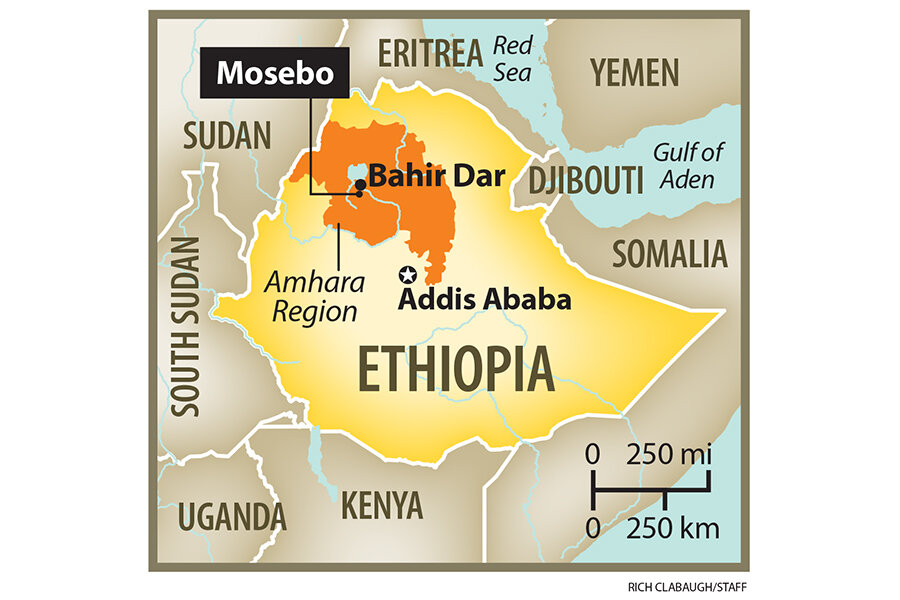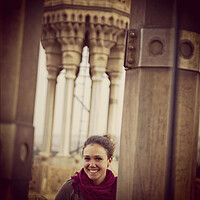Ethiopia's key to safer births? Better roads
Loading...
| Mosebo, Amhara Region, Ethiopia
From the booming capital of Addis Ababa to Ethiopia’s remotest border regions, excavators are busy scraping earth, making way for roads that will finally connect the far reaches of this largely rural country.
Ethiopia’s full-court press toward a modern road network is certainly a boon to its industry and agriculture. But it may also help Ethiopia shed its notoriety as one of the worst places to be an expectant mother or a newborn. Women name distance and transit as two of the greatest obstacles to accessing health services.
Ethiopia’s maternal and newborn mortality rates are among the world’s highest, though its maternal mortality rates are declining faster than anywhere else on the continent. Many deaths are caused by childbirth complications that could be handled by someone with medical training. Sanitation is another problem. Yet more than 60 percent of women still give birth at home, according to government estimates. (Some international aid groups estimate that number is closer to 80 percent.)
Logistical hurdles and cultural mores – along with the sheer remoteness of so many villages -- make use of a health facility a huge reach for most Ethiopian women.
The country is nowhere near its goal of “home delivery free” villages, aiming for just 30 percent of kebeles, the local term for a unit of villages, to gain this status by September, according to Dr. Addis Tamire, chief of staff for the minister of health. He spoke to reporters in Ethiopia’s capital the same day that his boss stood alongside USAID officials in Washington to announce a new global push to end preventable child deaths.
Stories like that of Ergedu Mitiku illustrate why the national goal here is modest.
When she went into labor three months ago, the one ambulance in Ms. Ergedu’s rural district had a flat tire. So she set out on foot for the nearest health center, 40 minutes away. She decided not to use the village’s “traditional ambulance” – a wide-framed stretcher designed to carry expectant mothers to the nearest road to wait for a rare passing vehicle.
Today, as she nurses her infant in her dirt-floor home, Ergedu seems quite nonchalant about how far she walked while in labor.
Yet for rural women to insist on giving birth in a village health facility requires a determination that many do not have, especially when family elders and husbands argue against it.
Ethiopia’s recent campaign of building more health facilities solves only part of the access problem.
In a 2011 official survey, 71 percent of Ethiopian women cited transportation as a barrier to health access – the most frequent response – and 66 percent cited distance as well.
To remedy this, the health ministry began coordinating with the rural roads authority as it built health facilities throughout rural Ethiopia. Federal and regional representatives now meet quarterly to map out health facilities and roads in tandem.
“There is a direct connection between women and this road construction,” says Simachew Nigatu Alemu, the general manager of the Rural Roads Authority for Amhara Region, where Ergedu lives. “They will not suffer from delivery.”
In Amhara, the regional government is in the midst of a five-year plan to build more than 11,000 miles of road. Three years into the project, 4,400 miles are done, says Mr. Simachew.
The goal is for every kebele to have a gravel road that connects to a paved road, and to the district center. If successful, every kebele will have a health post that provides basic services like contraception, pre- and post-natal care, and counseling on delivery. Health workers can offer consultation and refer expectant mothers to a health center for the actual birth.
Residents of every kebele are required to lend a hand either by their labor or by giving materials or money. Most choose labor and the residents throw a big party when the work is done.
These parties are a major marker of progress, says Simachew, who grew up as a farm boy in a village 50 miles from the nearest gravel road. Today, he’s an economist who remembers that, “There was no chance to get to a hospital, or to health centers. People were simply dying.”
In Simachew’s boyhood, villagers used to think doctor visits were an extravagance and that their local cures were fine. Today, his home village is car-accessible and medical treatment is common. The two improvements are closely linked, he says.
But even where there are roads, major obstacles remain. On a recent afternoon in Mosebo, which lies about 20 miles outside the Amhara regional capital of Bahir Dar, a typical rainy season storm leaves the gravel and dirt road slick and pocked with mud pits. Even SUVs slide, their wheels spinning uselessly in the reddish-brown clay. Chinese-contracted road crews working on a federally commissioned paved road have to halt their work.
Compounding the challenge, only 1,200 ambulances exist in the whole country – and Dr. Addis casts that as an improvement.
Fasika Menge, who works at the health post in Mosebo, says their one ambulance – an SUV -- serves 160,000 people.
For the foreseeable future, birth plans are likely to continue to include knowing which men will carry the “traditional ambulance” when the time comes – if women choose to leave the home at all.
Ariel Zirulnick reported from Ethiopia with the International Reporting Project.








